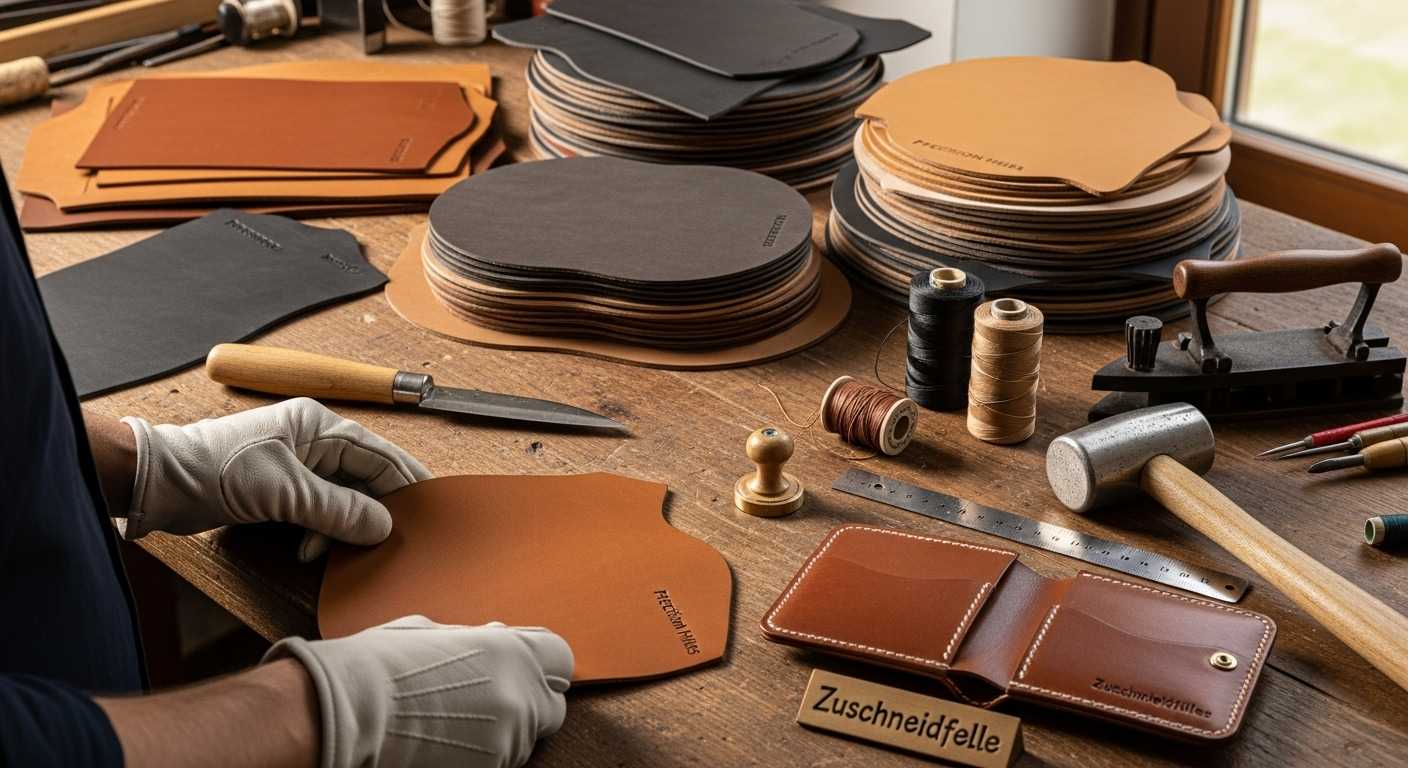Zuschneidfelle are specially prepared leather hides used as precision-cut bases for crafting. The word is German – zuschneiden means “to cut” and Felle means “hides” – so it literally means “cutting hides”. These hides are hand-selected and treated to ensure consistent texture, thickness, and quality, effectively becoming the “premium cuts” of the leather world. In other words, they give hobbyist leatherworkers a huge head start: with fewer flaws and a uniform surface, your pieces can be cut and stitched much more cleanly. Using zuschneidfelle means your wallets, belts, jackets, or art projects will come together looking more professional and lasting longer.
Imagine a workbench with smooth leather panels ready for a project. That’s the essence of zuschneidfelle – hides that are already smooth, uniform, and free of scratches or holes. Starting with these precision hides saves you time hunting for perfect leather. As one leathercraft guide notes, zuschneidfelle “bring a unique blend of versatility and quality” to projects, helping even beginners achieve excellent results. In practice, this means you can focus on your design – laying out patterns, cutting shapes, and sewing pieces – confident that the material won’t let you down. These hides truly elevate your leathercraft by making each step easier and the finished item stronger.
Types of Zuschneidfelle
Zuschneidfelle come from various animal hides, each with its own feel and strength. Common types include:
-
Sheepskin: Very soft and lightweight, perfect for delicate items like gloves, clothing, or fine accessories. Its fine grain gives an elegant finish.
-
Goatskin: Durable yet supple; ideal for everyday items such as handbags, small bags, or shoes that must endure wear while remaining flexible. Its natural texture adds character to each piece.
-
Cowhide: Thick and tough, offering maximum strength. Cow zuschneidfelle are great for heavy-duty projects like belts, wallets, jackets, or upholstery that need to last. These hides develop a rich patina over time while holding up to rough use.
-
Exotic skins: (Crocodile, ostrich, etc.) – Rare, patterned hides used in luxury goods. They have unique textures and are usually very expensive. These exotic zuschneidfelle are chosen for high-end fashion accessories rather than everyday hobby projects.
Common Uses and Projects
Zuschneidfelle are remarkably versatile. Crafters use them wherever durable, high-quality leather is needed. For example:
-
Fashion & Accessories: Designers and hobbyists rely on zuschneidfelle for leather clothing and accessories. They make beautiful coats, jackets, handbags, belts, and even shoes, since the hides’ consistency helps each cut look sharp. A precision hide ensures seams align and edges stay clean, which “elevates any outfit” made from the leather.
-
Home & Upholstery: These hides add a touch of luxury to furniture and interiors. Think reupholstered sofas, custom car seats, or leather home décor. The strength of zuschneidfelle means items like chairs or car interiors stay elegant and resistant to wear over years. Their rich texture brings sophistication to any room.
-
Craft & Artistic Projects: Leatherworkers use zuschneidfelle for smaller craft projects too – wallets, journal covers, straps, and mixed-media art. Because the hides are uniform, even intricate designs (like detailed tooling or embossed patterns) come out well. The texture and finish of zuschneidfelle enhance the appeal of handmade leather goods.
-
Other Creative Uses: Hobbyists also make pet collars, keychains, patches, and more from these hides. For example, a sturdy zuschneidfell can become a durable dog collar or a custom leather case. In fact, many crafters note that repairing a favorite leather item is much easier with prepped hides – you can patch or replace parts without worrying about matching thickness.

Working with Zuschneidfelle
Working with zuschneidfelle is very similar to working with any leather, but with some key tips to get the best results. Always use sharp cutting tools: a fresh rotary cutter or craft knife on a cutting mat will slice through the hide cleanly. Dull blades tend to snag and fray the edges, so replace blades often. Mark your pattern on the hide with chalk or a scratch awl and cut slowly in one smooth motion to maintain accuracy. The image above shows a craftsman hand-stitching a leather panel, which highlights the next step: sewing. After cutting, use strong leather needles and thick thread to stitch pieces together. Many artisans prefer hand-stitching zuschneidfelle for the strongest seams, though a heavy-duty sewing machine can work too. In short, treat the hides with care – measure twice, cut once, and use steady, deliberate motions. With practice you’ll notice the precise hides make sewing and finishing much more reliable than uneven offcuts.
Even regular maintenance can be done just like other leather goods. Storing zuschneidfelle properly keeps them usable: tuck any extra hides or finished items away from heat and sun in a cool, dry spot. High humidity or sunlight can dry out or discolor the leather. Cleaning is simple: gently brush or wipe with a soft, slightly damp cloth to remove dust or dirt. Never soak the leather – for spots or stains, lightly dab with a mild (non-alkaline) soap solution, then let it air dry. Conditioning is a good idea too: every few months apply a bit of leather conditioner to finished pieces to keep them supple and prevent cracking. A little care like this can keep your zuschneidfelle-based creations soft, shiny, and long-lasting.
Sustainability & Ethics
If you’re concerned about the environmental impact of leathercraft, zuschneidfelle have some positive aspects. Many of these hides are by-products of the meat industry – meaning they come from animals already used for food – so no animals are raised only for your craft materials. This can make them more ethically sourced than buying hides from unknown origins. Also, look for hides that are vegetable-tanned. Vegetable tanning uses plant-based extracts instead of harsh chemicals, which is gentler on the environment. By choosing hides from tanneries that practice ethical farming and eco-friendly tanning, you can feel better about the footprint of your hobby. Responsible sourcing and sustainable tanning make zuschneidfelle a kinder choice for both animals and the planet.
Conclusion
In summary, zuschneidfelle are the “precision hides” your leathercraft projects deserve. They bring together heritage craftsmanship and practical quality: finely cut, durable leather that makes every cut, stitch, and finish easier. As one leathercraft guide puts it, these hides are “the unsung heroes of leathercrafting” – the very foundation for beautiful, durable pieces. By selecting a high-quality zuschneidfell for each project and giving it the right tools and care, you’ll see a noticeable jump in your results. Whether you’re sewing a simple wallet or designing a detailed jacket, starting with these premium hides truly elevates your work from ordinary to extraordinary.



